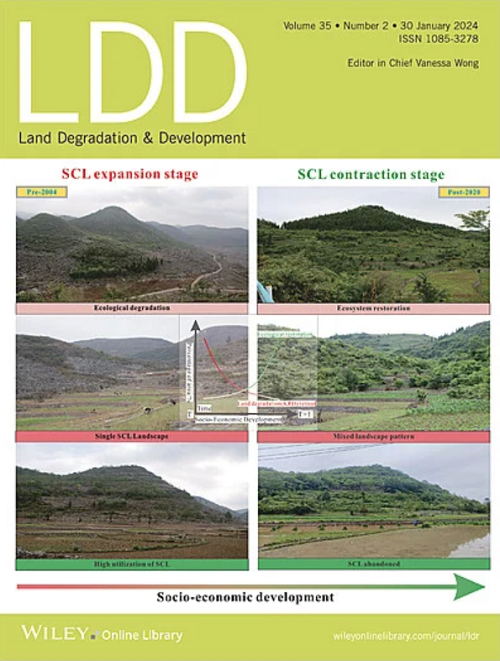植被对巴西退化旱林再生过程的影响
IF 3.6
2区 农林科学
Q2 ENVIRONMENTAL SCIENCES
引用次数: 0
摘要
巴西的卡廷加属世界上最多样化的干旱森林之一,但其原有覆盖面积的一半已经退化。自然再生受到气候和土壤条件以及现有成林地层的影响。尽管这一过程非常重要,但人们对卡廷加地区的这一过程仍然知之甚少。因此,我们的研究旨在分析人为干扰、植被覆盖和土壤特性如何在不同的卡廷加植被覆盖水平下影响再生地层。研究在巴西最干旱的地区进行。所选地点分别代表低(I 区)和高(II 区)归一化差异植被指数。六块菜地(每块 50 × 20 米)被划分为成生层,四块菜地(每块 10 × 10 米)被划分为再生层。所有菜地的表土都进行了取样。我们的研究结果表明,土壤特性与成虫层和再生层之间存在相互作用。二号区的多样性更高,独有物种数量更多,而一号区则以抗逆性更强的物种为主,如 Aspidosperma pyrifolium Mart.土壤中的碳和氮含量与再生地层的多样性呈显著正相关。数据表明,植被覆盖率、丰富度和多样性较低的地区有荒漠化的迹象。本文章由计算机程序翻译,如有差异,请以英文原文为准。
Effects of Vegetable Cover on the Regeneration Process in Degraded Dry Forest in Brazil
The Brazilian Caatinga is among the most diverse dry forests in the world, yet half of its original coverage has been degraded. Natural regeneration is influenced by climatic and edaphic conditions, as well as the existing adult stratum. Despite its significance, this process remains poorly understood in the Caatinga. Thus, our study aimed to analyze how anthropogenic disturbance, vegetation cover, and soil properties affect the regenerating stratum under different levels of Caatinga vegetation cover. The research was conducted in the driest region of Brazil. The selected sites represent low (Area I) and high (Area II) normalized difference vegetation index. Six vegetable plots (50 × 20 m each) were delimited to study adult stratum, and four vegetable plots (10 × 10 m each) to regeneration stratum. Topsoil was sampled in all vegetable plots. Our results reveal interactions between soil characteristics and the adult and regenerating strata. Area II exhibited higher diversity and a greater number of exclusive species, while Area I was dominated by species more resistant to limiting conditions, such as Aspidosperma pyrifolium Mart. & Zucc. The C and N content in the soil showed a positive and significant correlation with the diversity of the regenerating stratum. The data suggest that the area with less vegetation cover, richness, and diversity shows signs of desertification.
求助全文
通过发布文献求助,成功后即可免费获取论文全文。
去求助
来源期刊

Land Degradation & Development
农林科学-环境科学
CiteScore
7.70
自引率
8.50%
发文量
379
审稿时长
5.5 months
期刊介绍:
Land Degradation & Development is an international journal which seeks to promote rational study of the recognition, monitoring, control and rehabilitation of degradation in terrestrial environments. The journal focuses on:
- what land degradation is;
- what causes land degradation;
- the impacts of land degradation
- the scale of land degradation;
- the history, current status or future trends of land degradation;
- avoidance, mitigation and control of land degradation;
- remedial actions to rehabilitate or restore degraded land;
- sustainable land management.
 求助内容:
求助内容: 应助结果提醒方式:
应助结果提醒方式:


